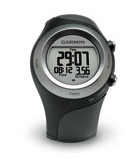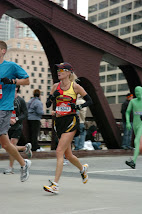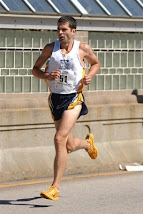 Yesterday, one of the athletes with whom I am working asked me: "Is it OK to do all of my training on the treadmill for the half marathon coming up in March?"
Yesterday, one of the athletes with whom I am working asked me: "Is it OK to do all of my training on the treadmill for the half marathon coming up in March?"I thought it was a great question, especially as we head into winter. I know his goals well, and where he is, so he received a very specific answer. But, as I was running today (outside for the first time in a week), I decided to explore this topic a little more deeply as a blog entry. In short, it really depends.
I used to go outside and tough it out under any conditions. My first 10-miler ever was when the air temperature was 10 F, and the winds were blowing heavily. I ran dressed like the Pilsbury dough boy, with a scarf wrapped twice around my nose and mouth to help me breathe. I've run in rain, freezing rain, pouring rain, sleet, wind, mud, ice, snow and triple-degree temps. I've been caught on the trail with the tornado sirens going off as a twister touched down less than 6 miles from me; and I've been caught on the trail, alone at night, only to find no light whatsoever available to me and more than a few miles to go. So, it's not that I am not tough enough to brave some questionable conditions.
Running on the treadmill has more than just those obvious benefits--protecting you from less than agreeable conditions.
But, there is one caveat: The treadmill needs to be calibrated, accurate and of very high quality. Treadmill speeds and distances can vary wildly, seriously misleading you into believing that you were running a specific pace or distance. Generally speaking, you get what you pay for. The less expensive, fold-up treadmills are far less accurate. There are a few brands (e.g., Precor) that have come out on top of numerous speed and distance accuracy tests. If you consistently run on a particular treadmill, make sure you've done your research.
Here are some advantages of treadmill running:
1. Pace teaching. I've run so many miles on my treadmill at specific paces, that I easily and quickly settle into desired paces and hold it steadily. I've "learned" exactly what certain paces feel like. I honestly believe it's so many miles on the treadmill that have given me the "machine like" quality to my legs and pacing that I've developed.
2. Safety. Ok, rather obvious, but there are definitely times it's just flat out more safe to run indoors (late at night, icy conditions, lightning).
3. No cheating on the treadmill. You are forced to hold the pace (as long as you can hang on) until that portion of your run or workout is complete. If your treadmill is accurate, this is a no-brainer. You can't slack off.
4. Lower impact than road running. This can be great if you are recovering from an injury, but also a good measure if you are always running on asphalt or concrete. I wouldn't want to run all six of my weekly runs on roads, and sometimes the trails are not convenient to get to.
5. Successful hard workouts. If I have a particular workout coming up that requires a very specific pace over a certain distance (like 1K repeats), and the workout seems rather challenging, I will more often than not do it on the treadmill to be sure I'm nailing it. This is especially true if the paces might be impacted by terrain other than a 400M track (which for most of us isn't readily available).
And a few disadvantages of excessive treadmill running:
1. Burnout. Too many runs back-to-back on a treadmill become quite monotonous. I've learned to deal with runs of up to about 9 or 10 miles pretty easily, but beyond that, I really have a tough time. And it isn't a physical thing, it's all mental. I just get bored and my mind wants me to stop. And after several days of nothing else, I just dread hopping on the moving belt.. and sometimes call it the "dreadmill."
2. Lack of strengthening supporting tendons, ligaments and muscles. Let's face it; if you only run on a treadmill and then suddenly go run a single track trail with a few rocks and roots, if you're lucky, your stability system (e.g. peroneal tendons) will only be sore. Worst case, you will be far more likely to roll your ankle or otherwise hurt yourself.
3. Preparedness for road running (impact). Yes, the treadmill is lower impact. A lot lower. If you are going to be competitive on road racing, you need to do at least some of your miles on the road to prepare your musculoskeletal system for the rigors of what's coming.
4. Learning to pace on your own. Sure, treadmill can help teach pacing, but if you don't go out and verify that you can hold your pace and practice it without the treadmill, don't expect it to work on race day.
5. Inability to deal with race day conditions. If you've never run in wind, cold, heat, mud or other inclement conditions, you might be surprised on race day. You should experience each of these to some degree if you ever expect to race in such conditions.
6. Lack of hills. I hate hills. Really. Those of you who know me know that I will go to great lengths to avoid races with hills if I care about my time. But, that being said, running hills as either part of your regular run or as striders at the end or even full-on hill repeats will make you more powerful. And if race day has hills (up AND down), you'd better have practiced on a few of them.
A few tips on successful treadmill running:
1. Treadmill isn't equivalent to running outdoors. Lack of wind, a moving belt, etc., make the treadmill just slightly easier than an outside run. Set your treadmill to a 1% incline always as a baseline equivalent.
2. Break up the run. Consider even something as simple as one minute at one pace, the next minute at another, and go back, alternating minutes. Expand to longer times, and possibly vary many slightly different speeds. It gives your mind something to look forward to. If your goal is to run 7.5 mph for the whole run after a warm-up, try varing between 7.3 and 7.7, inching up and down as certain minutes tick by.
3. Mark the segments of your run. You might have seen my "10 beads" entry. I keep a stash of pretty, hand carved bone beads in the windowsill by my treadmill. I just move them one at a time from the left to the right of the treadmill when I am doing intervals or segments of a fartlek of any kind. I used to have a string of beads across the front of my treadmill, and I would slide beads to the right as certain percentages of my run were complete.
4. Watch a movie or t.v. show, or listen to an audio book. Ok, this is only for the easy runs. If you are running hard, you won't be able to concentrate. But, this can be a great way to click off the miles if you are just trying to put some distance onto the belt.
Treadmill running can be a great supplement to your training. But don't let it rob you of the joy of running outdoors! Most of us didn't fall in love with the sport at the gym.








No comments:
Post a Comment